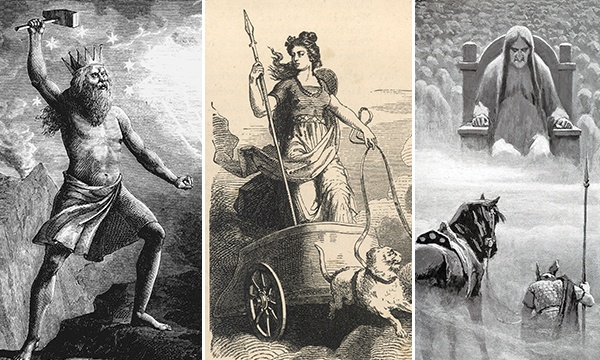Remarkably, Norse lore covers the entire history of the world; it’s not typical for a culture’s mythology to tell us how the world will end. For the Vikings, that “happened” at Ragnarök, the twilight of the gods, but the start of time is not neglected either. The stories even speak of the great void of Ginnungagap that existed even before the universe was created. Creation myths are often among the strangest of all stories, and the Norse version is no exception. We learn how the first god was licked into existence from a block of salty ice by a primeval cow called Auðumbla. That god was called Búri, and he was the grandfather of perhaps the greatest of all the gods, Odin.
Poetry, magic and war
Odin, who gave one of his eyes in exchange for wisdom, is, according to most sources, the “Allfather” of the gods; a fascinating shaman-like figure, emblematic of war, battle and death, but also poetry, music, prophecy and magic. He rode across the battlefield on Sleipnir, an eight-legged steed, with the ravens Hugin (thought) and Munin (memory) on his shoulders.
Thunderstorms and healing
Odin’s most famous son is, of course, Thor. As well as thunderstorms, Thor is associated with oak trees, and is said to protect mankind. It is less well-known that he was also a representative of healing and hallowing (sanctification). As well as his famous hammer, he possessed a magical belt and iron gloves, all with names of their own, named weapons being common fare for the Norse – something fans of JRR Tolkien will recognise.
Summer sun and radiance
Baldur, another of Odin’s sons, was a being of great beauty; the god of the summer sun, of radiance. In fact, it was said he was so bright that the light shone from him. Having had a dream foretelling his death, Frigg, his mother, made all the things of the Earth vow never to harm him. They all did, save the mistletoe, and it was a spear made of this innocuous plant that killed him, through the trickery of our next god, Loki.
Shapeshifting and amorality

Loki is a trickster god – an amoral figure who managed to inveigle his way into becoming Odin’s blood brother. His crimes against the gods were many, culminating with the beloved Baldur’s death. He was also a shape-shifter, and transformed into various animals. It was he, while in the form of a horse, who sired Sleipnir. Loki had other (divine) children, including the queen of the underworld, Hel.
Death and the underworld
Hel, ruler of Helheim, the Norse underworld, like gods of the dead in other cultures, is described as having skin resembling death itself (in this case, a bluish hue). She was sovereign of a realm of vast mansions, and it was Hel’s duty to provide food and lodging to those dispatched to her. There is a pleasing equality about the portrayal of the women of Norse mythology. Each is fully developed; none are mere bit-part players.
Love, fertility and seiðr
Such is the case with Freyja, another multifaceted figure, and, as with Thor and Odin, one of contradictions. Not only was she a beautiful figure, goddess of love and fertility, she was also associated with war, battle, wealth, death and a particular form of Norse magic known as seiðr. It was in fact she who taught the magic arts to Odin himself, and she is a perfect example of the complex and intriguing nature of the Norse gods.
More about:
















































